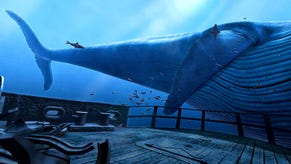Let's play Quake 3, Half-Life and Unreal on vintage PC hardware
Eurogamer is 20 years old - and so is this retro PC.
Eurogamer celebrates its 20th birthday this week - an anniversary that happily coincides with Digital Foundry Retro creator John Linneman taking possession of a PC of the same vintage, swiftly followed by the acquisition of an appropriate CRT display. Just how well did the top titles of yesteryear run on what was high-end PC hardware way back in 1999?
Across this special DF Retro Let's Play, we'll be running Windows 98 on original hardware, installing games from original, physical CDs (remember those installer dialogues?) and seeing just how performant two of the most powerful 3D accelerators of the era actually were - the classic 3DFX Voodoo 2 and underdog Nvidia's Riva TNT2 Pro.
Yes, we've got direct feed capture of the proceedings, but on top of that we also filmed the monitor itself, to give some idea of how these classic games actualy looked on the display technology of the time. And based on our session, you really have to wonder whether today's LCDs can hold a candle to classic CRT technology: instant response, no fixed resolution limitations, no 'sample and hold' motion blur and stunning colour reproduction and clarity. Is this an example of a regression in technology over the last two decades? It's a topic we'll be returning to at some point.
As for the hardware specifications of the retro PC, check this out:
- CPU: Intel Pentium III 700 Mhz Coppermine Slot 1 version (0.18 μm fabrication process) with 133MHz FSB
- Mainboard: Biostar M6VBE motherboard
- Memory: 384MB RAM
- Primary Display Adapter: ELSA Erazor III TNT2 Pro graphics card
- Secondary Display Adapter: 3DFX Voodoo 2 12MB
- Sound Card: Sound Blaster PCI sound card
- Storage: 20GB IDE HDD
- Display: Sony G400 19-inch CRT monitor
In the video, we check out some of the key PC experiences that gamers would have experienced in 1999. Top of the list is the classic Quake 3 Arena from id Software - the first game from the studio to launch requiring the user to own an OpenGL-compatible 3D accelerator. This game released in December of 1999 - so very early on in Eurogamer history, but PC gamers of the time would have enjoyed the three-map Quake 3 Arena Test that launched at the end of April, along with several updates as the game neared completion.
After that, we move onto further classics of the 1998/1999 period, including the original, non-Steam version of Half-Life from Valve Software, plus the incredible (for the time) Unreal from the fledgling Epic Megagames. Our journey concludes with Jurassic Park: Trespasser - a game that acts as a precursor of sorts for Far Cry, Crysis and the ultra-realism period in PC gaming history. It's a game where its ambitions massively outstrip the actual capabilities of PC hardware of the time - but just how well did it hold up on a high-end machine of the period, and just how did the developers strive to bring unprecedented levels of realism to PC gaming?
Technology has evolved by leaps and bounds in the last couple of decades, but the tail-end of the last millenium was a pivotal moment for gaming. When Eurogamer launched, PlayStation was firmly established with PS2 en route. Meanwhile, Sega's Dreamcast had just arrived in the USA with a European release mere weeks away. However, Eurogamer was built from the passion of the Loman brothers' love for Quake and competitive LAN gaming - and the PC space was the place to be for cutting-edge hardware and some of the most advanced software engineering in the business. It was a magical time for the platform - and hopefully this hour of retro PC gaming will stir a few happy memories for some of the site's long -term readers, as well as its staff!










